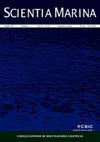预测南露脊鲸的繁殖热点,南露脊鲸(鲸目目:神秘鲸目),沿着巴西南部海岸线
IF 0.9
4区 生物学
Q4 MARINE & FRESHWATER BIOLOGY
引用次数: 1
摘要
为了预测巴西南部南露脊鲸的潜在繁殖热点,我们使用了一个“仅存在”数据集的Maxent模型。该数据集是从系统的空中调查和巴西亚·德桑托斯监测计划和马里尼奥斯监测计划的公共记录中获得的。由于空间自相关,在建模过程中使用了3028条记录中的528条。模型中使用的解释变量是海岸距离、线性、坡度和基底类型。这些模型是分别为无人陪伴的成年人(Ad)和母子对(Fe)创建的。根据曲线下面积值,这两个模型都显示出良好的准确性(Ad=0.974;Fe=0.958)。海岸距离是无人陪伴成年模型最相关的解释变量(54%),而海岸线性度与母子对模型更相关(82%)。与无人陪伴的成年人相比,母子对的估计区域更局限于沿海地区,这可能是因为沿海地区有大量的小牛庇护所。这是第一项预测巴西南露脊鲸潜在繁殖热点的研究,其结果将有助于对这些鲸鱼进行更直接的管理,并提供进一步的研究机会。本文章由计算机程序翻译,如有差异,请以英文原文为准。
Predicting the breeding hotspots of the southern right whale, Eubalaena australis (Cetartiodactyla: Mysticeti), along the southern Brazilian coastline
To predict the potential breeding hotspots of southern right whales in southern Brazil, we used a Maxent model with a “presence-only” dataset. The dataset was obtained from a systematic aerial survey and public records of the Programa de Monitoramento de Cetáceos da Bacia de Santos and Sistema de Apoio ao Monitoramento de Mamíferos Marinhos. Because of spatial autocorrelation, 528 records out of 3028 were used in the modelling process. The explanatory variables used in the models were coastal distance, linearity, slope and substrate type. The models were created separately for unaccompanied adults (Ad) and mother-calf pairs (Fe). Both models showed good accuracy according to their area under the curve values (Ad=0.974; Fe=0.958). Coastal distance was the most relevant explanatory variable for the unaccompanied adult model (54%), whereas coastal linearity was more relevant for the mother-calf pair model (82%). The estimated area for mother-calf pairs was more restricted to coastal areas than that for unaccompanied adults, possibly owing to the high number of shelter areas for calves near the coast. This is the first study to predict the potential breeding hotspots of southern right whales in Brazil and its results will allow for a more directed management of these whales and provide further research opportunities.
求助全文
通过发布文献求助,成功后即可免费获取论文全文。
去求助
来源期刊

Scientia Marina
生物-海洋与淡水生物学
CiteScore
2.10
自引率
0.00%
发文量
21
审稿时长
6-12 weeks
期刊介绍:
Scientia Marina is the successor to Investigación Pesquera, a journal of marine sciences published since 1955 by the Institut de Ciències del Mar de Barcelona (CSIC). Scientia Marina is included in the Science Citation Index since 1998 and publishes original papers, reviews and comments concerning research in the following fields: Marine Biology and Ecology, Fisheries and Fisheries Ecology, Systematics, Faunistics and Marine Biogeography, Physical Oceanography, Chemical Oceanography, and Marine Geology. Emphasis is placed on articles of an interdisciplinary nature and of general interest.
 求助内容:
求助内容: 应助结果提醒方式:
应助结果提醒方式:


